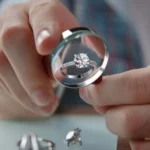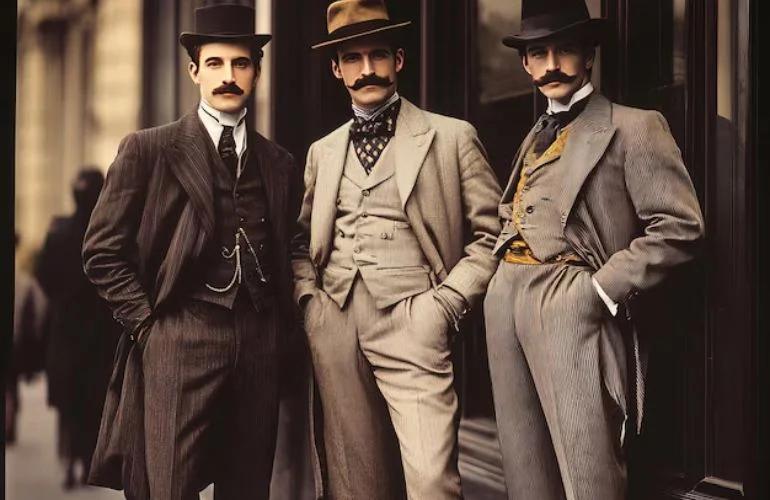The 1920s was a decade of significant change, and nothing captured the transformation better than 1920 suit fashion. Known for its elegance and sophistication, the suits worn by men in the 1920s set the standard for modern men’s fashion. During this time, clothing was more than just a necessity—it became a symbol of identity and status. Suits were designed with a mix of traditional elements and fresh, bold choices that mirrored the excitement of the “Roaring Twenties.”
What Made 1920 Suit Fashion So Iconic?
When we think about 1920 suit fashion, the first things that come to mind are the tailored cuts, striking accessories, and use of high-quality materials. Suits from this era were not only stylish but also functional. The suits featured a sleek, fitted design that emphasized the shoulders and waist, giving men a sharp and polished look.
The key to understanding the uniqueness of 1920 fashion lies in the details. From the wide lapels to the bold pinstripes, everything was carefully crafted to reflect the energy of the time. Men’s suits during the 1920s were all about making a statement, and the designs reflected the social and economic optimism following World War I.
Must read 1950 Fashion Female: A Look into Iconic Women’s Styles of the 1950s
The Structure of 1920 Suits
A standard 1920 suit was typically made up of three main pieces: the jacket, trousers, and vest (or waistcoat).
The Jacket
The jackets in the 1920s were designed to be tailored and fitted, enhancing the wearer’s physique. These jackets typically had:
- Wide lapels, which added a sense of grandeur and style.
- A structured shoulder line, creating a sharp, masculine silhouette.
- A high-button stance, with two or three buttons being common, allowing the tie and shirt to be showcased.
During colder months, men often wore overcoats on top of their suits, further highlighting the tailored, layered look that was so important in 1920 fashion.

The Trousers
Trousers were another key element of the 1920s suit. Unlike the slim-fit trousers of today, the trousers from this era were high-waisted and often loose-fitting, providing comfort while still maintaining a clean, formal appearance. Cuffs (also called turn-ups) at the bottom of the trousers were quite popular, giving a little flair to the look. As the decade progressed, pleats became more common, allowing for easier movement and flexibility.
The Vest (Waistcoat)
The vest, or waistcoat, was an essential part of the three-piece suit in the 1920s. Vests were often made from the same fabric as the jacket and trousers, completing the look. They were fitted, with a button-up front, and typically had pockets for a pocket watch, adding to the gentlemanly feel of the time. Some men also wore double-breasted vests, further enhancing the elegance of their ensemble.
Fabrics and Colors
Suits in the 1920s were crafted from high-quality materials, which contributed to their sharp and polished look. Wool was the most common fabric used, as it was durable, comfortable, and appropriate for the formal nature of the time. However, during warmer months, lighter fabrics like linen and cotton were also popular.
When it came to colors, the 1920s offered a wide range of options. While darker shades such as navy, black, and charcoal were standard choices for business or formal occasions, lighter colors like beige, cream, and light grey were trendy for casual settings or summer events. Pinstripes were incredibly popular, especially for business suits, giving men a professional yet stylish appearance.
Accessories That Completed the Look
No discussion of 1920 suit fashion would be complete without mentioning the accessories that accompanied these suits. Accessories were a critical part of completing the overall look.

Hats
Men in the 1920s rarely left the house without a hat. Fedoras, bowler hats, and flat caps were popular choices that complemented their suits. These hats not only added to the style but also served as a social marker of class and status.
Pocket Squares and Ties
Pocket squares, often made from silk or linen, were a colorful addition to a man’s suit. Ties, on the other hand, were thin and often in bold colors or patterns, allowing men to show off their personality and style.
Shoes
Men’s shoes in the 1920s were polished and classic. Oxford shoes and two-tone brogues were common choices. These shoes were well-crafted, and their shine added to the overall sophistication of the outfit.
The Influence of 1920 Suit Fashion on Modern Style
The legacy of 1920 suit fashion can still be seen in modern menswear. Today, elements of the 1920s style are incorporated into both casual and formal wear. Tailored suits with sharp lines, wide lapels, and high-quality fabrics continue to define elegance in men’s fashion.
Fashion designers often draw inspiration from the Roaring Twenties, creating collections that blend classic and contemporary styles. The timeless appeal of the 1920s suit proves that well-crafted clothing never goes out of style.
Popular Figures Who Shaped
Celebrities, politicians, and other public figures in the 1920s greatly influenced suit fashion. People like Charlie Chaplin, Al Capone, and Duke Ellington were often seen sporting the finest suits of the time. Their public appearances in these stylish outfits helped cement the 1920s look as a symbol of power, success, and sophistication.
Even today, these iconic figures serve as fashion references when people think of the stylish, polished look of the 1920s.
Women and 1920 Suit Fashion
While men’s fashion in the 1920s was revolutionary, women also embraced the suit in unique ways. Women of the time began to challenge traditional gender roles, and some chose to wear suits, especially during social events or while working. This was a bold statement, as women’s suits were often adapted from men’s styles but made to fit the female form. Women’s suits became a symbol of empowerment and freedom during the 1920s.

Conclusion
The 1920 suit fashion marked a turning point in men’s style, blending sophistication with bold, new ideas. The sleek cuts, high-quality fabrics, and detailed accessories of the time still inspire today’s fashion world. Whether you’re a fashion enthusiast or just curious about the past, understanding the significance of 1920s fashion offers insight into how style can both reflect and shape an era.
For further reading on men’s fashion through the decades, you can explore more here.
What made 1920 fashion unique?
1920 fashion was known for its sharp tailoring, wide lapels, and use of high-quality materials like wool. The design emphasized a man’s shoulders and waist, creating a sleek and polished look that was both stylish and functional.
What fabrics were popular for suits in the 1920s?
Wool was the most common fabric for suits in the 1920s, providing durability and comfort. However, lighter fabrics such as linen and cotton were also used during warmer months.
Why were hats an essential part of 1920 fashion?
Hats were a symbol of class and status in the 1920s. Popular styles like fedoras and bowler hats complemented a man’s suit, adding a sense of elegance to his outfit.
How did women incorporate suit fashion in the 1920s?
Women began to wear suits during the 1920s as a symbol of empowerment and freedom. These suits were often adapted from men’s styles but tailored to fit women’s bodies, marking a shift in traditional gender roles.
Are 1920s suit styles still popular today?
Yes, elements of 1920 fashion, such as tailored fits, wide lapels, and high-quality fabrics, continue to influence modern menswear. Many fashion designers draw inspiration from the 1920s, creating timeless, elegant styles.











